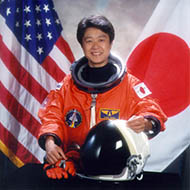 Mukai Chiaki. (Public Domain photo, NASA) Mukai Chiaki. (Public Domain photo, NASA) Mukai Chiaki was the first Japanese woman to go to space, and one of less than 60 women to ever share that privilege. As both an astronaut and surgeon, Mukai is an inspiration to young women breaking into the sciences. Early Years and Education Mukai was born in Tatebayashi, Gunma, Japan in 1952. Though Mukai grew up watching the space race happen, she did not have aspirations at that time to be an astronaut, but rather, she wanted to be a doctor. Her brother suffered from aseptic necrosis, a disease that caused his leg bones to be very brittle and caused difficulties when he walked. Mukai witnessed how her brother was teased and was determined to help others who suffered from illness. She also saw how much her brother improved with advanced medicine, which only made her more persistent in accomplishing her dream of going into medicine. In 1977 she earned a doctorate in medicine and in 1988 she earned another doctorate in physiology; both degrees were awarded to Mukai from the Keiō University School of Medicine in Tokyo. A year later, in 1989, Mukai was board certified as a cardiovascular surgeon by the Japan Surgical Society. Transitioning from Surgery to Space Mukai accomplished her first goal by becoming a doctor at the age of 25. She went on to work as a heart surgeon and held a variety of positions at numerous hospitals. In 1983 she became chief resident in cardiovascular surgery at Keio University Hospital and she earned the title of assistant professor of the Department of Cardiovascular Surgery at the university. Just three years later, Mukai’s career would become entangled with space. In 1985 Mukai was just one of three payload specialist selected by the National Space Development Agency of Japan (NASDA) for the ST-47/Spacelab-J mission; however it wasn’t until nine years later that she first flew into space on board the Columbia on the 15-day STS-65 mission where she helped conduct scientific and medical experiments. While working with the NASDA, Mukai became a visiting scientist in the Cardiovascular Physiology Division of the Space and Biomedical Research Institute at NASA Johnson Space Center from 1987 to 1988. And, from 1992 to 1988 she worked at as a research instructor at the Department of Surgery at Baylor College of Medicine in Houston as well as a visiting professor professor in the Department of Surgery at the Keio University School of Medicine. In 1998 Mukai hit another milestone - she became the first Japanese citizen to fly twice in space. As a payroll specialist onboard the Discovery space shuttle on the STS-95 mission, Mukai flew onboard with U.S. Senator John Glenn, who was the first man to ever orbit the earth in 1962. On their mission together in 1998, Glenn, age 77, became the oldest person to ever fly in space. During the mission, Mukai helped conduct medical, material and aging research, of which Glenn was a test subject for. Since then Mukai has gone on to teach at the International Space University, serve as the Director of Space Biomedical Research office, advice the Japanese Aerospace Exploration Agency (JAXA) and become the director of the Applied Space Science Research for JAXA. In 2015 she became Vice President of the Tokyo University of Science. An Ongoing Influence Mukai is an inspiration to women in the sciences and continues to influence the industry. She has shared her dreams and success by working in education and motivating others to chase their goals. She once wrote that she’s very thankful to those who encouraged her in pursuing her ambitions.“And, I strongly believe that education enables us to envision and pursue our dreams,” she wrote.
0 Comments
|
Archives
July 2017
Categories
All
|
 RSS Feed
RSS Feed